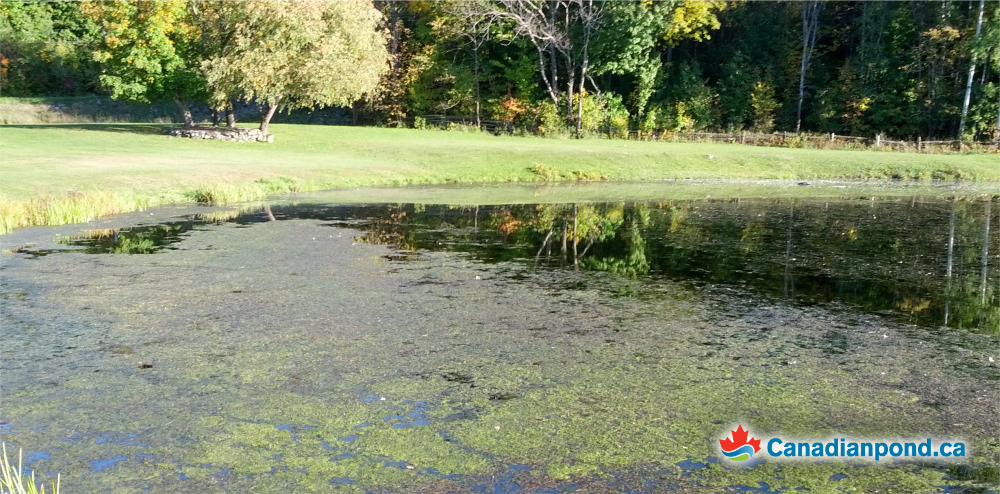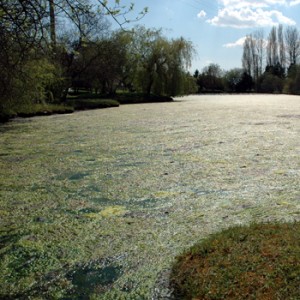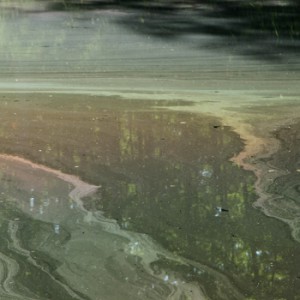Green murky waters in the summertime: help!
Summertime at the pond: the heat, the holidays and sometimes… green murky waters!
There is nothing more dis-heartening than to have your cooler packed and swimming trunks ready for a day at the pond only to find that you have the mother of all algae blooms taking over your prized pond like a scene out of War of the Worlds! Algae forms when there are too many nutrients in the water. Fish and bird feces, fish food, grass clippings, agricultural and animal waste and fertilizers from lawn application or flowering shrubs all flow into the pond and accumulate in the water column.

In shallow ponds the water heats up and algae start to grow. When algae are deprived of nutrients they will die through starvation. If already established, a short turnaround is unlikely. We added bacteria to remove the nutrients in the pond that were feeding the algae. On sunny days algae will float to the surface and reproduce. Algae love shallow warm water which is low in oxygen. When sunlight can reach the bottom of a pond it will greatly increase the risks of algae growth!
What is the relationship between algae and bacteria? In what situations are there diatoms, filamentous algae, or blue-green algae?
Why did bacteria have such a great impact? Under optimal conditions, heterotrophic bacteria can double their population within 20 minutes; algae take about 24 hours. The bacteria also have a much greater surface area to volume ratio than algae. Greater surface area facilitates the uptake of nutrients. Bacteria are rapidly preyed upon; this results in the nutrients being bio transformed into natural and beneficial food for the invertebrates and fishes in your pond. It is largely for these reasons that appropriate bacteria can remove soluble nutrients, making them unavailable for algae.
Diatoms have the special requirement of silica for their growth. Filamentous algae are favoured in moving water. The attached filaments remain in position, whereas planktonic forms move down stream with the current. Blue-green algae can fix nitrogen from the air and also form air pockets, which make them, float at the surface. Blue-green algae often occur in polluted water, which is turbid. Their ability to float provides them with light in otherwise dark waters.
 Reasons for algae growth
Reasons for algae growth
Do you add any fertilizers to your lawn or plants? One gram of fertilizer in the water can create 11kg of algae! It is very bad for ponds. If your pond has no aquatic vegetation to help filter nutrients and remove unwanted food for algae then you might be in for a nasty surprise! Fountains tend to heat up the water because they throw water into the air and on sunny days the water gets warmer as it flies through the air.
Aquatic plants will definitely help with the quality of your pond. If you look at natural ponds you see the cleanest ones have well established plant growth which helps to cool the water and aerate naturally. The main reason to keep a shoreline vegetated is to filter surface run-off and to keep edges cool and protected. Bacteria are a natural way to help restore a pond to a healthy balance. Natural bacteria to fight the nutrients that cause algae can be very effective when combined with aeration but if algae suddenly seem to bloom when adding bacteria it is just a coincidence. Heavy rain and surface run-off loaded with nutrients will make the bloom happen. Algae has a quick reaction when the conditions are right; light reaches the bottom (wherever the water is less than 4’ deep), nutrients (natural from soil run-off or from fertilizer or from a nearby lawn) are available and unused.
 When the temperature is warmer than usual (often at this time of year we break temperature records and heat waves are common) any type of algae will thrive if the conditions for their growth are present. Chemical treatments would kill the algae but will also accumulate in the water body. You could add an algaecide to your pond and the chemicals would kill the algae. The algae would die, sink to the bottom and decompose. The water would heat up and more algae would grow and you would add more poison and the cycle would continue. Decomposing algae is food for more algae. Fish are also adversely affected by heat. At 27° Celsius (80° Fahrenheit) trout will start to die. Keeping plants to cool the water and an aerator will help keep temperatures low but heat waves can still have devastating results!
When the temperature is warmer than usual (often at this time of year we break temperature records and heat waves are common) any type of algae will thrive if the conditions for their growth are present. Chemical treatments would kill the algae but will also accumulate in the water body. You could add an algaecide to your pond and the chemicals would kill the algae. The algae would die, sink to the bottom and decompose. The water would heat up and more algae would grow and you would add more poison and the cycle would continue. Decomposing algae is food for more algae. Fish are also adversely affected by heat. At 27° Celsius (80° Fahrenheit) trout will start to die. Keeping plants to cool the water and an aerator will help keep temperatures low but heat waves can still have devastating results!
Do you have freshly planted shrubs, bushes or grass? Many landscapers would not plant these without a lot of fertilizer because they don’t want a legal battle. All sod (tourbe) is fertilized enough to warrant its growth in the worst conditions for a few months. Every time it rains, it releases nutrients. If you have a decorative stone edge it is simply a heater for the water; more heat, less oxygen available. It is a vicious cycle.
In one study using liquid bacteria to control algae it was reported: “During the early periods of the trial, it was found that the levels of filamentous algae floating on the surface varied considerably from week to week. One week it would cover half the dam, and the next, it would only be in small clumps on the sides. After a few weeks of observation, it was established that climatic conditions had a profound effect. Not only did the sunny days produce much more plant growth, but the prevailing wind concentrated the filamentous algae in one corner of the dam.” This was a 4 ½ month study using weekly doses of liquid beneficial bacteria. In the end, the results were spectacular but there is no quick solution.
A permanent and long-term solution is to create conditions so the water stays clear and clean for fish and people by using oxygen and plants. If you have installed aeration in the pond this is a very good thing! If you have a natural aquatic shoreline with plants to filter and cleanse the water you will be more likely to be able to enjoy your pond on hot summer days. For swimming, fishing and playing with the grand-kids there is nothing like the backyard pond on a hot summer day. Creating a natural pond is a long-term project that requires patience and an understanding of the natural forces that affect natural conditions.
Read also:
Quebec Vert magazine published in the May-June 2010 edition a series of in-depth articles on water quality and management of water bodies on golf courses in Quebec.
CanadianPond.ca participated in the article titled “Défi de l’eau claire” available here in PDF format (copyright Québec Vert):
- “Le défi de l’eau claire 1” Part One (PDF available in French only)
- “Le défi de l’eau claire 2” Part Two (PDF available in French only)
- Visible cyanobacteria blooms? Important precautions for you and your family
- Controlling algae in your pond